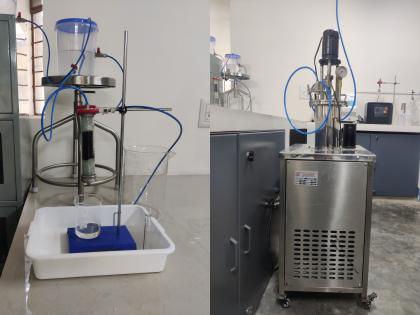Indian Institute of Science develops a sustainable method for removing heavy metal contaminants like 'Arsenic' from groundwater
By Anubha Jain | Updated: June 13, 2024 17:56 IST2024-06-13T17:55:28+5:302024-06-13T17:56:45+5:30
Researchers at the Centre for Sustainable Technologies (CST), Indian Institute of Science (IISc) have developed a remediation process for ...

Indian Institute of Science develops a sustainable method for removing heavy metal contaminants like 'Arsenic' from groundwater
Researchers at the Centre for Sustainable Technologies (CST), Indian Institute of Science (IISc) have developed a remediation process for removing toxic and heavy metal contaminants like arsenic or fluoride from groundwater. The three-step, patent-pending solution ensures that the removed heavy metals are disposed of in an environment-friendly and sustainable manner, instead of sending untreated heavy metal-rich sludge to landfills from where they can potentially re-enter groundwater.
Yagnaseni Roy, Assistant Professor at CST, whose lab has developed the method discussed the procedure in detail with Lokmat Representative Dr. Anubha Jain and said, “In every technology that exists, arsenic can be removed to make water clean. However, after the arsenic/fluoride gets removed, something should be done as it comes back slowly over time into the soil or water, and that aspect is not given due consideration in existing methods. Our process is designed to solve this problem.” She further said that this method converts the toxic elements into the organic form. On average, these organic species are approximately 50 times or much less toxic than the inorganic form present in groundwater. Rao further said, “The system can also be adapted to remove fluoride, with the last step changed to precipitation to form calcium fluoride, which has very low solubility in water. The system is designed in a way that no waste is coming out into the environment in any way.” Roy’s team is currently checking the feasibility of tackling other heavy metals using the same system.
The system is easy to assemble and operate. Talking about vision and plans Roy said that the researchers of CST-IISc have collaborated with the INREM Foundation and Earthwatch, NGOs, to deploy and test this method in rural areas such as Bhagalpur in Bihar and Chikkaballapur in Karnataka. She said, “Fluoride can be treated to Chikkaballapur in Karnataka and hence, our team has done a field visit there. We are gradually bringing technology to the rural areas and in fields with the support of these NGOs and are operating at the pilot scale. With further funding will take this work to a big scale soon.”
The first step in the process developed by the IISc team involves passing the contaminated water through a bed of biodegradable adsorbent made of chitosan-based adsorbent doped with iron and aluminum compounds. The adsorbent bed grabs the toxic inorganic arsenic through electrostatic forces and complex formation between arsenic and the adsorbent. A novel aspect of the technology is that the alkaline wash – used to repeatedly regenerate the adsorbent bed after its saturation – is recycled within the system.
In the second step, the alkaline wash solution, which is essentially sodium hydroxide and arsenic in water, is taken to a membrane system to separate the two. While the sodium hydroxide solution (the alkaline wash) is taken back to regenerate the bed, the arsenic concentrated in the other stream is now ready to be taken to the third step: bioremediation. The membrane process serves to concentrate the arsenic ahead of bioremediation. In the bioremediation step, the toxic inorganic arsenic is converted to low-toxicity organic arsenic via methylation by microbes found in cow dung. This decreases toxic inorganic arsenic to below the maximum permissible limit specified by WHO standards, within eight days. The remaining cow dung sludge can be safely disposed of in landfills since the arsenic is locked in it in an organic form.
Open in app